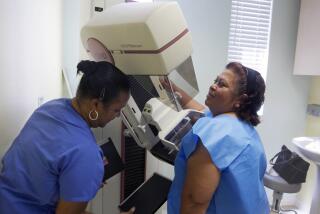PERSPECTIVE ON WOMENŌĆÖS HEALTH : Mammography Radiates Doubts : An activist coalition fighting breast cancer needs to question the line doled out by the cancer Establishment.
It has been widely (and with reason) charged that the makers and marketers of silicone breast implants, and self-interested plastic surgeons, made women their guinea pigs. But what of that other, and greater, scourge of women, breast cancer? There is reason to believe that women are equally ill-served by the cancer Establishment, especially in its unrelenting promotion of mammography.
Breast cancer now strikes one in nine women, a dramatic increase from the one in 20 measured in 1950. This year, 180,000 new cases and 46,000 deaths are expected. Hearings scheduled Feb. 5 in Washington by the Breast Cancer Coalition, an advocacy group loosely modeled on AIDS activists, could not seem more timely.
The coalition wants more federal funding for the National Cancer Institute (NCI) to increase its research into the causes and treatment of breast cancer, and to improve delivery of breast health care--including diagnostic screening. In pursuing these goals, the coalition has been co-opted into supporting the policies of the cancer Establishment--NCI and the American Cancer Society--which is fixated on basic research, diagnosis and treatment. Cancer prevention receives only an estimated 5% of the annual $1.8 billion NCI budget.
Breast cancer is not the only cancer on the rise. While its incidence has increased 57% since 1950, overall cancer has increased 44%, now striking one in three people and killing one in four. Male colon cancer is up 60%, testis, prostate and kidney cancer up 100%, and other cancers, such as malignant melanoma and multiple myeloma, more than 100%. The cancer Establishment trivializes evidence linking these increasing rates with avoidable exposure to cancer-causing industrial chemicals and radiation that permeate our environment--food, water, air and workplace.
The cancer Establishment maintains, on tenuous evidence, that a fatty diet itself is a major cause of breast cancer, while ignoring contaminants in fat. Carcinogenic pesticides, such as the highly persistent chlordane and dieldrin, which concentrate in animal fats, are known to cause breast cancer in rodents. Elevated levels of DDT and PCBs are found in human breast cancers. An Israeli study found that breast cancer deaths in younger women recently dropped by 30%, despite a substantial increase in consumption of animal fat. This drop followed, and seems linked to, regulations that reduced previously high levels of DDT and related pesticides in dairy products. These pesticides act by mimicking the action of estrogens or by increasing estrogen production in the body, which in turn increases the risk of breast cancer. A related concern is lifelong exposure of all women to estrogenic contaminants in animal fat, because of their unregulated use as growth-promoting additives in cattle feed.
In 1977, NCIŌĆÖs director of endocrinology, Dr. Roy Hertz, warned, without effect, of breast cancer risks from these contaminants.
More ominous is the enthusiastic endorsement by the cancer Establishment of massive nationwide expansion of X-ray mammography, including routine annual screening. While there is a general consensus that mammography improves early cancer detection and survival in post-menopausal women, no such benefit is demonstrable for younger women.
Furthermore, there is clear evidence that the breast, particularly in premenopausal women, is highly sensitive to radiation, with estimates of increased risk of breast cancer of up to 1% for every rad (radiation absorbed dose) unit of X-ray exposure. This projects up to a 20% increased cancer risk for a woman who, in the 1970s, received 10 annual mammograms of an average two rads each. In spite of this, up to 40% of women over 40 have had mammograms since the mid-1960s, some annually and some with exposures of 5 to 10 rads in a single screening from older, high-dose equipment.
Significant studies on radiation risks to the breast have been well known since the late 1960s, including evidence that mammography, especially in younger women, was likely to cause more cancers than could be detected. A confidential memo by Dr. Nathaniel Berlin, a senior NCI physician in charge of large-scale mammography screening, in 1973 may explain why women were not warned of this risk: ŌĆ£Both the (American Cancer Society) and NCI will gain a great deal of favorable publicity (from screening, and) . . . this will assist in obtaining more research funds for basic and clinical research which is sorely needed.ŌĆØ
Thus, once again, suspect technology was applied to women on a large scale, in spite of clear warning signals and with insufficient knowledge of the likely consequences. (On a smaller scale, but even more ethically appalling, was the use until last April of industrial polyurethane foam to coat silicone breast inserts, despite clear evidence that its manufacturing contaminants and breakdown products were carcinogenic. As with mammography, no serious studies have been launched to find out what happened to women in whom the foam was implanted, or indeed to women carrying any type of silicone implant.)
The risks of mammography, especially for premenopausal women, persist with the lower radiation doses (about one-half rad per screening) found in modern facilities with dedicated equipment and licensed operators. A large Canadian study conducted from 1980 to 1988 found a 52% increase in early breast cancer deaths in women aged 40 to 50 who had 10 annual mammograms, compared to women given just physical examinations. More recent concern comes from evidence that 1% of women carry a gene that increases their breast cancer risk from radiation four-fold.
The coalition should insist that the NCI and American Cancer Society initiate an immediate, large-scale, well-publicized study to further investigate the role of past mammography in increasing breast cancer rates, and to investigate future cancer risk from mammography as currently conducted under widely varying conditions. Women should also be informed of their X-ray exposure and individual and cumulative risks each time they undergo mammography. The coalition should demand an immediate ban on obsolete high-dose X-ray equipment, and the abandonment of routine mammograms on premenopausal women.
The coalition should also encourage a crash program to develop and make available safe alternatives to mammography, apart from physical examination. Two that show the most promise are magnetic resonance imaging and transillumination with infrared light. The expansion of mammography should be put on hold, especially in view of the 1991 conclusion of the General Accounting Office that ŌĆ£there are more than enough machines to meet the screening needs of American women.ŌĆØ
The Breast Cancer Coalition represents a welcome trend toward active grass-roots involvement in public health. However, its current goals are too narrowly defined within the context of existing perspectives and institutional policies. The coalition needs broader and more radical strategies if it is to reverse the modern epidemic of breast cancer.






